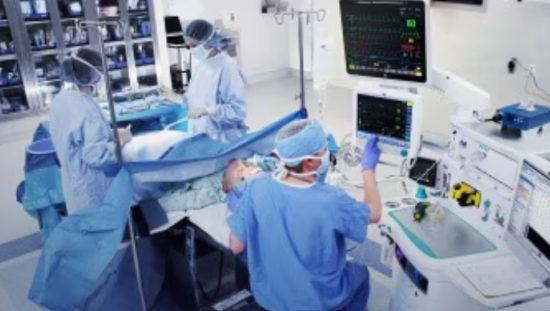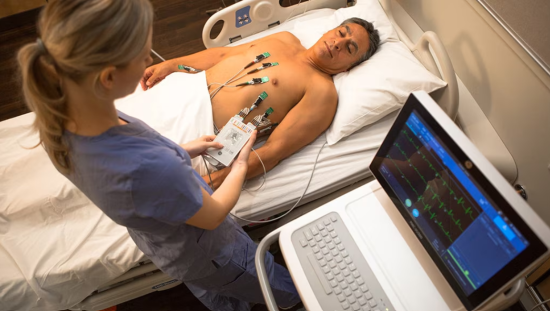An overview of strategies for reversing neuromuscular block
In this podcast, Dr. Heidi Lewald reviews the strategies for reversing neuromuscular block.
Show Notes
Transcript
Speakers
Welcome to this podcast series produced by the Association of Anesthetists and sponsored by GE HealthCare. On the subject of neuromuscular monitoring in 2024, are we practicing to the highest possible standards?
In this podcast, Dr. Heidi Lewald reviews the strategies for reversing neuromuscular block.
Insights, interviews, and best practices by clinicians for clinicians. Welcome to GE HealthCare's Clinical View podcasts.
Andrew Mortimore:
Welcome everybody to this podcast produced by the Association of Anesthetists and sponsored by GE HealthCare. On the subject of neuromuscular monitoring in 2024, are we practicing to the highest possible standards? The podcast will cover four main areas.
Firstly, the pharmacology of reversal agents, their benefits and side effects, then an overview of strategies for reversing neuromuscular block, followed by an update on the latest American and European guidelines on monitoring neuromuscular block, and then finally, techniques of quantitative neuromuscular monitoring, which is the best equipment to use. We hope you will enjoy this podcast and gain something from it. Okay, and so we're joined now by Professor Heidrun Lewald, who is a Professor of Anesthesia at the Department of Anesthesia and Intensive Care Medicine at the Technical University of Munich in Germany.
She has a background in basic as well as clinical research with a focus on the neuromuscular junction, pharmacodynamics and kinetics of muscle relaxants and their reversal agents, as well as neuromuscular monitoring. So thanks very much Heidi for joining us, and you've very kindly agreed to speak to us in this podcast about the pharmacology of reversal agents, their benefits and side effects. So thank you very much for that.
And if you're okay, I'd like to ask you the first question, which is, what are the key differences between traditional and newer reversal agents in terms of their mechanism of action and effectiveness?
Professor Heidrun Lewald:
So what we consider to be traditional reversal agents are the choline esterase inhibitors, such as neostigmine. And as the name says, they inhibit the choline esterase in the neuromuscular junction, and by that they increase the concentration of acetylcholine in the synaptic cleft. And as acetylcholine competes against the muscle relaxant for binding at the receptor, the increased concentration of acetylcholine increases just a chance of it to bind to the receptor and thus it restores neuromuscular transmission and muscle contraction.
So choline esterase inhibitors act indirectly and they act intrasynaptically by inhibiting the degradation of acetylcholine. And the advantage of this indirect mechanism of action is that it works irrespective of what non-depolarizing muscle relaxant you use. It simply works for all of them.
Sugammadex, on the other hand, is a cyclodextrin, so eight glucose molecules in a circular structure with eight negatively charged side chains attached. So it is a huge molecule, which after you inject it intravenously, it rains completely intravascular. And Sugammadex was specifically designed to only bind rocuronium, but it also works with a slightly lesser efficacy for vecuronium, as are both steroidal muscle relaxants.
So it does not work if you gave your patient one of the benzo isoquinolones, namely atracurium, cisatroquarium, or mivacurium. So if we go back to the mechanism of action, what happens when Sugammadex is injected is that intravascular rocuronium is encapsulated and by that inactivated. And this really within moments leads to a concentration gradient of free rocuronium from intravascular to extravascular.
So intravascular rocuronium concentration is low, extravascular concentration, namely at the neuromuscular junction, is high. And this gradient then pulls the rocuronium away from the neuromuscular junction back into the bloodstream, where it is then also encapsulated and inactivated by free or unbound Sugammadex. So you have the indirect and intrasynaptic choline S-rays inhibitor neostigmine versus the intravascular encapsulator Sugammadex.
Now coming to the second part of the question, if you have this in mind, differences regarding the effectiveness of these two drugs are really easy to understand because with its direct encapsulating mechanism, reversal with Sugammadex is possible at any depth of rocuronium-induced neuromuscular block. It's simply a matter of dose. So you have to have 16 milligrams per kilogram for immediate reversal, 4 milligrams per kilogram if your neuromuscular monitoring shows you a post-tetanic count of 2 and above, and 2 milligrams per kilogram as soon as you have a return of the second twitch of your train of force stimulation.
Now with neostigmine, it's a bit trickier because as we said, it acts indirectly and you cannot inhibit more cholinesterase than the patient has. And if all of the cholinesterase inhibited, even if you give more neostigmine, you will not see an increase in recovery. And this is what we call a ceiling effect.
And because of this known ceiling effect, it is recommended to wait until a certain degree of spontaneous recovery from neuromuscular block has already occurred. So if you expect a fast and reliable recovery, it's ideal to wait for the train of force ratio to recover to at least 20%. For shallower blocks below 20%, neostigmine is also going to work.
It just needs more time. And of course, you have to monitor until the train of force ratio is above 90% to confirm full recovery.
Andrew Mortimore:
What a fabulous answer. Thank you very much for that. So moving on to the next question, could you discuss for us the most common side effects associated with current reversal agents and how clinicians can mitigate these risks?
Professor Heidrun Lewald:
Sure. If we start with neostigmine, well, all side effects can be explained by the physiology we all once learned in med school. And they're all due to the fact that acetylcholine is not only a neurotransmitter in the somatic nervous system, but also in the autonomic nervous system.
And especially in the parasympathetic system, it acts as a pre- and post-scanionic neurotransmitter. And this is why symptoms of parasympathetic overstimulation, such as bradycardia, hypotension, bronchoconstriction are common with neostigmine. And that is also why to mitigate these effects, we always combine neostigmine with a parasympathetic drug such as glycoparalyte.
Now looking at Sugammadex, when it was introduced 15 years ago, it was thought that we would only see very few side effects because it was so specific for rocoronium. And we thought, you know, maybe allergic reactions could occur simply because everyone can react allergic to a drug. But it turns out, and a recent report just confirmed this, that the two most common side effects are bradycardia and bronchospasm, just as with neostigmine.
Now the exact mechanism is not fully understood, but you really have to be aware of this. This can also occur when you use Sugammadex in your patient. However, number one adverse event, as was expected, is allergic reactions.
And there's one really interesting aspect about this, and that is allergic reactions against Sugammadex can occur even after a patient has received his very first dose. And that is because every one of us is exposed to cyclodextrins pretty much everywhere in everyday life. Not only in cosmetics or deodorant sprays or anything that encapsulates and neutralizes unpleasant odors, cyclodextrin and especially gamma cyclodextrin, so the molecule that is the backbone of Sugammadex, are officially approved in the European Union and other countries as food additives.
So you really have to be aware, even after first dose of Sugammadex, you can have an allergic reaction in your patient.
Andrew Mortimore:
Thank you very much for that, it's fascinating. And then another question, how do newer agents like Sugammadex compare to neostigmine in terms of safety profiles and patient outcomes?
Professor Heidrun Lewald:
That is a very interesting question and is a question that is asked fairly often, you know, should we prefer one over the other? Is one better than the other? Well, first of all, we have to exclude profound, deep and moderate block for which only Sugammadex can be used if you want to have effective reversal.
But if we look at reversal of residual block above a train of four ratio of 20%, we actually cannot give a clear recommendation for one drug over the other regarding safety profiles and patient outcomes. And I also personally think that it is not the reversal drug that makes a difference. It is whether or whether or not you use quantitative neuromuscular monitoring with every patient that receives a muscle relaxant.
You have to have a number on your screen as a basis for any subsequent decision on how to reverse. And whether you reach the goal, which is to extubate the patient at a train of four ratio of 0.9 or above with Neostigmine, Sugammadex or simply the time it needs for spontaneous recovery is absolutely secondary. Key to increase patient safety and patient outcome is quantitative neuromuscular monitoring.
Andrew Mortimore:
Thank you for that. So can I just ask you then, I know that the monitoring is not available in all circumstances in all settings. So if you had to just help somebody to convince the budget holders that they should get the equipment necessary to allow the neuromuscular monitoring, how could you sell that quickly?
What are the most important things that they could say?
Professor Heidrun Lewald:
The most important things are that you dose your drugs adequately, you by that ensure faster and reliable recovery, you reduce postoperative complications such as pneumonias. There are numerous studies out there showing also that you can decrease length of hospital stay, reduce complications. So it all not only increases patient safety, which should be our primary goal as physicians to have the maximum safety for a patient.
It also reduces hospital costs and subsequent costs for the hospital, but also for the whole health care system.
Andrew Mortimore:
Okay. So finally, Heidi, could you tell me about Sugammadex and other steroidal drugs and how they can be used?
Professor Heidrun Lewald:
That is a very interesting and a very practical question. Now, as we said, Sugammadex was designed to encapsulate steroidal muscle relaxant. So of course, it's going to encapsulate other steroidal drugs as well.
Other drugs that we use during anesthesia, for example, dexamethasone, which we use to prevent postoperative nausea and vomiting. And in general, you can say that the dose, the effective dose is going to be decreased by about 30%. So when you look at dexamethasone, for example, you might regard increasing your dose by 30%.
Another question that is very often asked is what about Sugammadex and the effect on contraceptive hormones? We come across a lot of patients that might use contraceptives and they have surgery and we're going to reverse them with Sugammadex. So what do we have to tell the patients?
What considerations should we have? Well, there are no randomized control studies investigating the effect of Sugammadex on hormonal contraceptives, but there are some in vitro data for which recommendations can be extrapolated. And as I said, in general, it is estimated that Sugammadex decreases hormone levels up to 30%, which is approximately the level of decrease of delaying the intake of a contraceptive pill by 12 hours.
Now, does this mean that ovulation is not suppressed anymore after patients under oral contraception have been given Sugammadex? To be honest, we don't know and we probably never will know, but we should always inform our patients that they received Sugammadex, a drug, but we also should always keep in mind that a lot of other factors such as perioperative stress, other drugs that we give during anesthesia also influence the female cycle. But of course, as I said, we should always inform women of childbearing age that they should use other non-hormonal contraception measures for the rest of the cycle.
The Society of Obstetric Anesthesia and Perinatology has issued a statement regarding other highly hormone dependent moments in the life of a woman, namely pregnancy, where Sugammadex should be avoided to not influence the need of high hormone levels to maintain the pregnancy in early pregnancy. When it comes to near-term pregnancy, the same caution is issued, warning the use of Sugammadex or at least giving the advice to really think if you might not use neostigmine in these patients, because Sugammadex, by encapsulating steroidal hormones, might influence lactation. And only when lactation is established in these women does the Society of Obstetric Anesthesia and Perinatology consider it to be safe to be used in these women.
There's just one thing I would also like to add. We really have to be clear. These statements issued are a what we call primarily do no harm approach, simply because we do not still know enough about how the drug interacts with steroidal hormones.
If you are, however, in an emergency situation, you should never hesitate to use Sugammadex in these patients, irrespective of the stage of pregnancy.
Andrew Mortimore:
Brilliant. Thank you so much, Professor Lewald. I would like to extend the thanks of the Association of Anesthetists and our sponsors, GE HealthCare, for visiting us and letting us benefit from your knowledge and your wisdom.
Professor Heidrun Lewald:
You are very welcome. It was a pleasure being here.
Andrew Mortimore:
This concludes the podcast on neuromuscular monitoring in 2024. Are we practicing to the highest possible standards? And we would like to thank all of the speakers who have taken part.
We'd like to thank the Association of Anesthetists and we'd like to thank the sponsors, GE HealthCare.
Thank you for listening to Clinical View Podcasts. Brought to you by GE HealthCare. Expand your view at clinicalview.gehealthcare.com

Prof. Heidrun Lewald
Professor of anesthesia at the Department of Anaesthesia and Intensive Care Medicine at the Technical University of Munich in Germany.
Prof. Heidrun Lewald currently works at the Klinik für Anaesthesiologie, Technische Universität München and does research in anesthesia with a focus on neuromuscular transmission and obstetric anesthesia.









